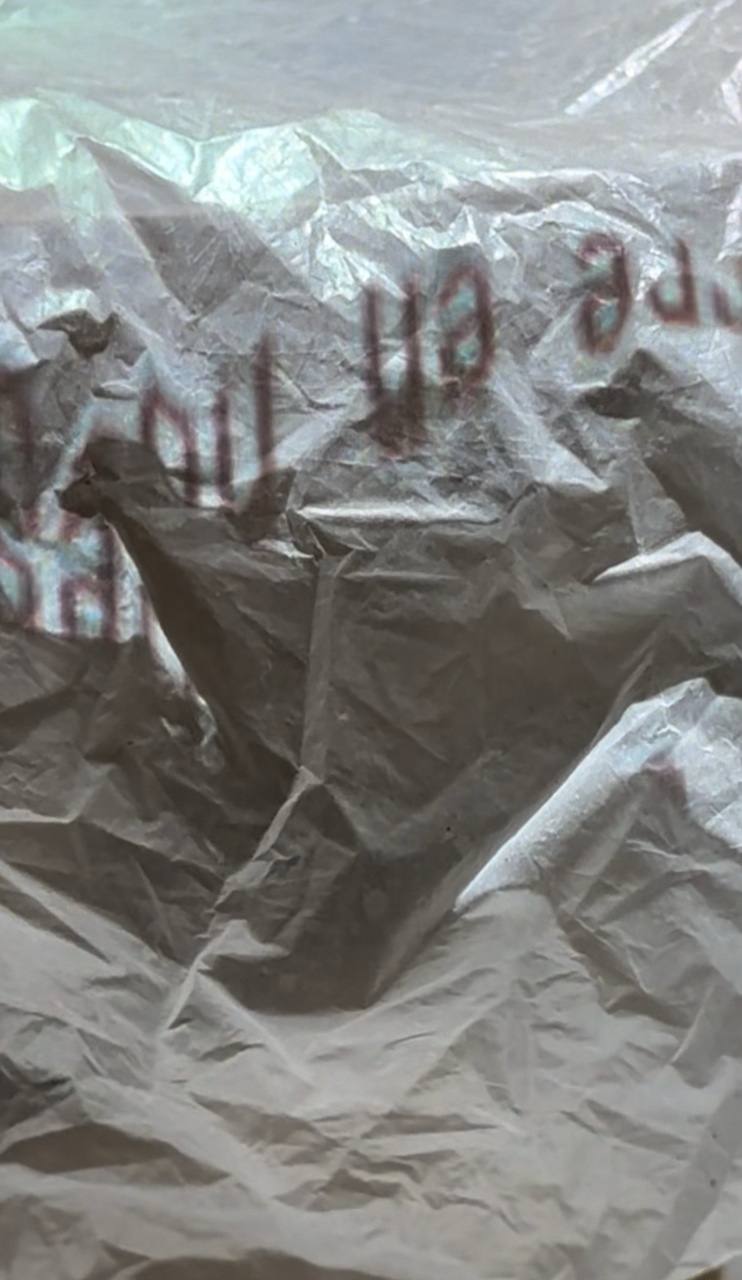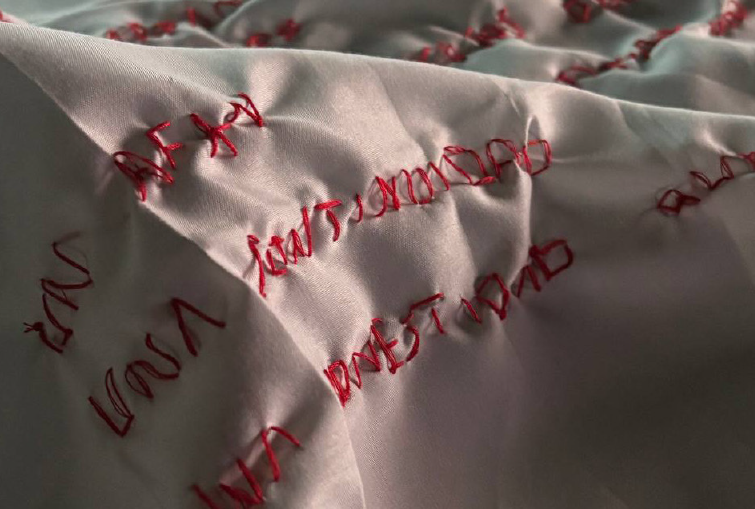/ ESP
QUIENES SOMOS CUANDO NADIE NOS VE
2024
Instalación Microcontrolador Arduino, sensor PIR, plástico, proyección
Dimensiones variables
El proyecto cuenta con un ventilador que se activa mediante un sensor de proximidad cada vez que alguien se acerca.
Cuando se enciende el ventilador, genera aire que hace flotar la tela que está suspendida sobre
él, evocando una presencia sutilmente dinámica, que a su vez responde a la proximidad y curiosidad del observador.
Las palabras se revelan y se ocultan, creando un poema que no se puede leer; cada intento de acercarse provoca que el movimiento de la tela disuelva su legibilidad, casi como si la pieza tuviera una intimidad propia que protege.
El objeto-tela responde, se activa y se resiste a una comprensión fija. Es un poema inasible, un gesto de intimidad y potencialidad que sólo existe en la interacción.
La pieza sugiere un impulso de traducción, de comprender lo que permanece en la sombra, metafóricamente hablando. Como un objeto que se sabe observado, el tejido reacciona al acercamiento humano, reflejando la tensión entre lo que oculta y lo que permite ver.
¿Qué significa ser, en este sentido, “cuando nadie nos ve”? La pieza establece un espacio de contemplación sobre la intimidad, sobre lo indecible y sobre el impulso de querer comprender lo que, al final, siempre se escapa.
La pieza existe por una fracción de segundo en el tiempo; nunca se recrea de la misma manera. La pieza sugiere que el acto de mirar se convierte también en un acto de creación, en el que el espectador activa sin querer, un espacio íntimo y efímero que nunca volverá a ser el mismo. Demostrando cómo la intimidad siempre va ligada a la privacidad. Invitar al espectador a comprender que la vulnerabilidad misma
se convierte en lenguaje, uno que sólo existe en toda su magnitud cuando se observa de cerca.
QUIENES SOMOS CUANDO NADIE NOS VE
2024
Instalación Microcontrolador Arduino, sensor PIR, plástico, proyección
Dimensiones variables
El proyecto cuenta con un ventilador que se activa mediante un sensor de proximidad cada vez que alguien se acerca.
Cuando se enciende el ventilador, genera aire que hace flotar la tela que está suspendida sobre
él, evocando una presencia sutilmente dinámica, que a su vez responde a la proximidad y curiosidad del observador.
Las palabras se revelan y se ocultan, creando un poema que no se puede leer; cada intento de acercarse provoca que el movimiento de la tela disuelva su legibilidad, casi como si la pieza tuviera una intimidad propia que protege.
El objeto-tela responde, se activa y se resiste a una comprensión fija. Es un poema inasible, un gesto de intimidad y potencialidad que sólo existe en la interacción.
La pieza sugiere un impulso de traducción, de comprender lo que permanece en la sombra, metafóricamente hablando. Como un objeto que se sabe observado, el tejido reacciona al acercamiento humano, reflejando la tensión entre lo que oculta y lo que permite ver.
¿Qué significa ser, en este sentido, “cuando nadie nos ve”? La pieza establece un espacio de contemplación sobre la intimidad, sobre lo indecible y sobre el impulso de querer comprender lo que, al final, siempre se escapa.
La pieza existe por una fracción de segundo en el tiempo; nunca se recrea de la misma manera. La pieza sugiere que el acto de mirar se convierte también en un acto de creación, en el que el espectador activa sin querer, un espacio íntimo y efímero que nunca volverá a ser el mismo. Demostrando cómo la intimidad siempre va ligada a la privacidad. Invitar al espectador a comprender que la vulnerabilidad misma
se convierte en lenguaje, uno que sólo existe en toda su magnitud cuando se observa de cerca.



/ ENG
WHO ARE WE WHEN NO ONE SEES US
2024
Installation
Arduino microcontroller, PIR sensor, plastic, projection
Variable dimensions
The project features a fan that is activated by a proximity sensor every time someone approaches.
When the fan is turned on, it generates air that makes the fabric float that is suspended over it, evoking a subtly dynamic presence, which in turn responds to the proximity and curiosity of the observer.
The words are revealed and hidden, creating a poem that cannot be read; each attempt to get closer causes the movement of the fabric to dissolve its legibility, almost as if the piece had an intimacy of its own that protects it.
The object-fabric responds, activates and resists a fixed understanding.
It is an elusive poem, where each word seems to invite the viewer to come closer, only to then evade it, maintaining a gesture of intimacy and potentiality that only exists in the interaction.
The piece suggests an impulse to translate, to understand what remains in the shadow, metaphorically speaking. As an object that knows it is being observed, the fabric reacts to human approach, reflecting the tension between what is hidden and what is allowed to be seen.
What does it mean to be, in this sense, “when no one sees us”? The piece establishes a space of contemplation about intimacy, about the unspeakable and about the urge to want to understand what, in the end, always escapes.
The piece exists for a fraction of a second in time; it is never recreated in the same way. The piece suggests that the act of looking also becomes an act of creation, in which the viewer unwittingly activates an intimate and ephemeral space that will never be the same again. Demonstrating how intimacy is always linked to privacy. Inviting the viewer to understand that vulnerability itself becomes a language, one that only exists in its full magnitude when observed closely.
WHO ARE WE WHEN NO ONE SEES US
2024
Installation
Arduino microcontroller, PIR sensor, plastic, projection
Variable dimensions
The project features a fan that is activated by a proximity sensor every time someone approaches.
When the fan is turned on, it generates air that makes the fabric float that is suspended over it, evoking a subtly dynamic presence, which in turn responds to the proximity and curiosity of the observer.
The words are revealed and hidden, creating a poem that cannot be read; each attempt to get closer causes the movement of the fabric to dissolve its legibility, almost as if the piece had an intimacy of its own that protects it.
The object-fabric responds, activates and resists a fixed understanding.
It is an elusive poem, where each word seems to invite the viewer to come closer, only to then evade it, maintaining a gesture of intimacy and potentiality that only exists in the interaction.
The piece suggests an impulse to translate, to understand what remains in the shadow, metaphorically speaking. As an object that knows it is being observed, the fabric reacts to human approach, reflecting the tension between what is hidden and what is allowed to be seen.
What does it mean to be, in this sense, “when no one sees us”? The piece establishes a space of contemplation about intimacy, about the unspeakable and about the urge to want to understand what, in the end, always escapes.
The piece exists for a fraction of a second in time; it is never recreated in the same way. The piece suggests that the act of looking also becomes an act of creation, in which the viewer unwittingly activates an intimate and ephemeral space that will never be the same again. Demonstrating how intimacy is always linked to privacy. Inviting the viewer to understand that vulnerability itself becomes a language, one that only exists in its full magnitude when observed closely.